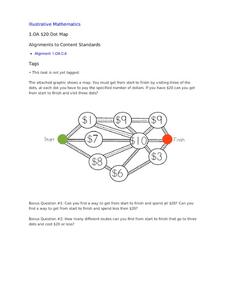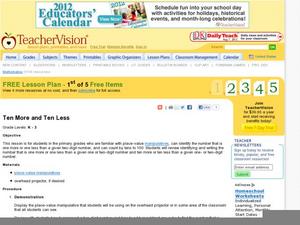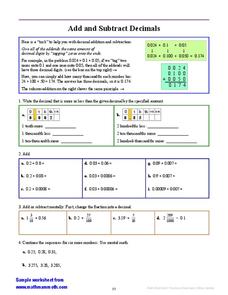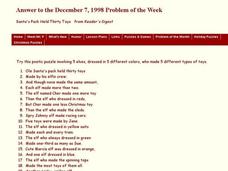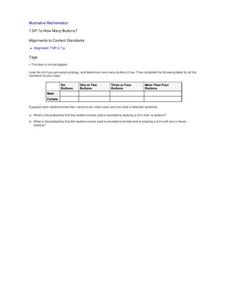Curated OER
10 More or 10 Less?
Take a rocket to the stars with using a math worksheet. Here, four sets of alien saucers, moons, rockets, and stars prompt young learners to match numbers with one more or ten more. Color the pictures for extra fun when students are...
Curated OER
More and Less
In this more than/less than worksheet, students start with the number on each cactus and double it. Then students continue down the column adding ten more or taking away ten as directed.
Illustrative Mathematics
“One More” Concentration
Help your primary learners develop an understanding of the concept of one more and one less using two sets of number cards. The first set of cards, all in one color, is the "one less" deck. The second set, again all in one specific...
Curated OER
Comparisons
Explore number value with learners through playing cards. They examine sets of three cards, adding up the value and comparing it to another set of three. Learners write in which is greater than or is less than to show number value...
Illustrative Mathematics
$20 Dot Map
Challenge the addition skills of young learners with this open-ended math problem. The task is simple, get from start to finish by connecting a series of three numbers. The trick is that the sum of the numbers must be less than...
Curated OER
Everyday Problems with Decimals
Review word problems and decimals with a worksheet that features everyday problems for your students to solve. Six problems provide space for both work and the solution, reinforcing the importance of showing one's work in word problems....
Curated OER
Number Rods
Working in a math center or an "I finished early" work station, young mathematicians will match in sequence pre-set-up rods of unifix cubes to numbers on a number line. To help differentiate tens from ones, use different colors to...
Curated OER
Ten More and Ten Less
Get learners to analyze two-digit numbers based on place value, and use manipulatives to add and subtract both 1 and 10. A place value chart is available, and you can project it during guided practice. Through visualizing...
Common Core Sheets
Comparing Fraction Relative Size
Which is the larger amount? Two-fourths of 10 dollars, or one-fourth of 100 dollars? This type of question is the main focus of a worksheet that has learners comparing fractions by their relative size. Each problem contains...
CCSS Math Activities
Smarter Balanced Sample Items: 7th Grade Math – Claim 4
Build the model right out of the box. A few sample items show teachers how Smarter Balanced assessments may approach Claim 4, modeling and data analysis. Pupils use their skills to create equations or expressions to model the situation...
Curated OER
Make a Ten
Youngsters mentally perform calculations involving addition and subtraction. They solve various addition and subtraction word problems using mental math and counters, write their own number stories, and solve various examples...
Curated OER
Relations and Graphs
Here is a simple, yet clever lesson on how to teach the important concepts of greater than, less than, and equal to. Pupils write their names down on grid paper - one letter per box. They compare their names and find a name that is...
Curated OER
Practicing Addition Strategies
For this math worksheet, students add the numbers 5 and 6 using two different methods. They first count up from six. Students say seven, eight, nine, ten, eleven to get to their answer. The second method is to use doubles. They think...
Curated OER
How Many Now?
In this more and less instructional activity, learners solve 6 problems in which multiples of ten are added or subtracted from a specified number.
Curated OER
Add and Subtract Decimals
In this decimal worksheet, students read about adding and subtracting, then complete a set of 31 problems, adding, subtracting, solving for values of expressions and solving equations.
Curated OER
Place Value: A Place for Apples
Second graders explore number values by completing math worksheets. For this place value lesson, 2nd graders identify the use of decimals in numbers and read a book about math called Apple Pigs. Students create number charts based on the...
Curated OER
Button Math
Use buttons, cards, and dice to perform simple math problems! This inventive lesson should be quite engaging for young learners. Kindergarteners use buttons to help them understand the concepts of greater than, less than, and equal to.
Curated OER
Santa's Pack Held Thirty Toys
In this geometry worksheet, 10th graders use the given clues to determine which of Santa’s elves dressed in which color and made which toy. The one page worksheet contains one problem with twenty-four clues. Answer...
Mathematics Vision Project
Module 6: Trigonometric Functions
Create trigonometric functions from circles. The first lesson of the module begins by finding coordinates along a circular path created by a Ferris Wheel. As the lessons progress, pupils graph trigonometric functions and relate them to...
Curated OER
How Many Buttons
Help learners explore the concepts of more than, less than, and equal to. They participate in a button attribute activity, play a game using buttons and a die, draw the sets of buttons in their journal, and play button bingo.
Curated OER
Rice Math Problems
Third graders practice solving math equations using rice as their subject. They translate situations involving rice into math equations in order to solve them properly. They also discover and practice using math vocabulary terms...
Curated OER
Multiplying in Columns, Standard Way
In this multiplying and carrying worksheet, students compare the standard algorithm with the multiplying in parts method and their examples, choose which method to use, and find the products. Students solve twenty problems.
Curated OER
Max's Math Adventures
In this math riddle learning exercise, students read through the rhyming math poem about the 'Card Castle Addition.' Students list all the ways they can come up with 14 using two numbers. Students then solve the final number sentence...
Curated OER
Ridgerunner
Young scholars jog at the beginning of the class while learning about the Appalachian Trail. They integrate math into the lesson by adding up how many miles they have run, and comparing it to distances on a real trail map.




